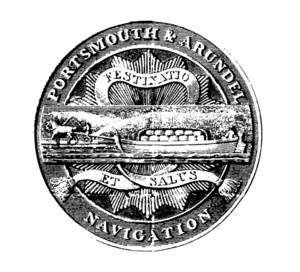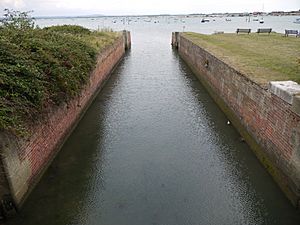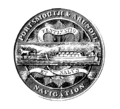Portsmouth and Arundel Canal facts for kids
The Portsmouth and Arundel Canal was a special waterway built in the south of England. It connected the city of Portsmouth with Ford, a village near Arundel. This canal was finished in 1823.
It was part of a bigger plan. The idea was to create a safe inland route from London all the way to Portsmouth. This way, boats could travel between the two cities without going into the English Channel. The Channel could be dangerous because of bad weather or even enemy ships.
The Portsmouth & Arundel Navigation company built this canal. It had three main parts:
- Two "ship canals" – one on Portsea Island and one going to Chichester.
- A "barge canal" that ran from Ford on the River Arun to Hunston. This is where it met the Chichester part of the canal.
Sadly, the canal never made much money. It was stopped in 1855, and the company closed down in 1888.
Sections of the Canal
Ford to Hunston: The Barge Canal
This part of the canal linked the River Arun at Ford to the main canal junction at Hunston. It had two special gates called locks at Ford. These locks helped boats go down 12 feet to reach the river.
Hunston to Birdham: The Ship Canal
This section was known as the Ship Canal. It connected Chichester Harbour at Birdham to the junction at Hunston. It also had two locks: Casher's Lock and Saltern's Sea Lock. This part of the canal was built to be very big. It was 8 feet deep and over 46 feet wide, so larger ships could use it.
Chichester Ship Canal: To the City
The Chichester Ship Canal (sometimes called the Barge Canal) started at the sea lock in Birdham. It went to the main Portsmouth and Arundel Canal junction at Hunston. From there, it turned north and ended in a basin in the southern part of the city of Chichester.
Portsea Canal: Across the Island
This part of the canal crossed Portsea Island. It ran from Eastney Lake in Langstone Harbour to a basin near what is now Arundel Street in Portsmouth. This section was also built for ships, but smaller ones. It could handle ships up to 150 tons. There were two locks at Milton: a sea lock and an upper lock.
Tidal Channels: Connecting the Parts
The Portsea section was connected to the rest of the canal by a long, 13-mile channel. This channel was dug through Chichester Harbour. It went past the south side of Thorney Island and north of Hayling Island. Finally, it crossed Langstone Harbour.
To make it easier for boats to travel between the Chichester and Portsea sections, a steam boat was built. It was called the Egremont. This boat could tow up to six 40-ton barges at once! For a while, the company also made Portsbridge Creek easy to use for boats.
History of the Canal
Planning and Building
The plans for the canal were finished in 1815. The special law needed to build it was passed by Parliament in 1817. At first, they thought it would cost about £119,000. By 1818, the cost went up to £125,452.
Building started in 1818 and the canal was ready in 1823. The final cost was £170,000. The main engineer in charge was James Hollinsworth.
To make sure the canal had enough water, a special pump was put in at Ford. This pump took water from the River Arun. The river at Ford is affected by the tides. So, the law said water could only be taken from the river at certain times. This was to stop salty sea water from getting into the canal.
For ships with tall masts, special iron swing bridges were built. These bridges could swing open to let the ships pass. This was different from the usual hump-back bridges found on canals.
How the Canal Worked
From the very beginning, the canal had many problems. In 1827, the Portsea section had to be emptied. People in Portsmouth were complaining that salt water was getting into their wells. Later, in 1845 and 1851, parts of this section were sold to a railway company.
In 1830, the prices for using the canal were lowered. For a short time, more goods were carried. This included 20 tons of marble from the Mediterranean Sea for the king! In the same year, the company made Ports Creek easier to use. This allowed barges to travel around the north of Portsea Island to Portsmouth Harbour. The canal was even used to carry gold and silver for the Bank of England.
However, the canal could not compete with sea travel. Shipping goods by sea was often cheaper and faster. By 1832, the canal company had to start carrying goods itself. By 1847, most of the canal was no longer used by boats. Only the Chichester arm was still navigable.
What Happened Later
On the remaining Portsea section, keeping the bridges in good condition became a big problem. The company eventually managed to pay to be freed from this responsibility.
The Chichester part of the canal was given to the Chichester local government in 1892. This was the same year the canal company officially closed down.
After the Canal Company Closed
Even today, in 2011, you can still see some parts of the Portsea section. A part of the Portsmouth-London railway line follows the old canal route. This is between Portsmouth & Southsea and Fratton stations.
Beyond the stations, a road called Goldsmith Avenue was built where the canal used to be. If you look off Goldsmith Avenue, you can still see the canal's path. Newer houses were built along roads called Old Canal and Towpath Mead. The old tow-path (where horses pulled boats) is now a footpath. It runs north of a caravan site and allotments on the south side of Locksway Road.
There is also evidence that the canal was filled in with a material called coke from a local gas works. The remains of the lock that led into Langstone Harbour can still be seen. This lock has been a special conservation area since 1977. It is also a Grade II listed structure, meaning it's an important historical building. In 1979, Portsmouth City Council agreed to spend £35,000 to fix up the lock over the next ten years.
Images for kids









